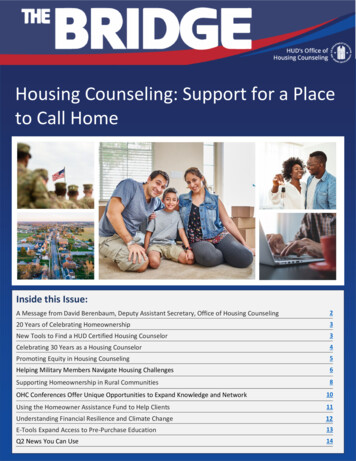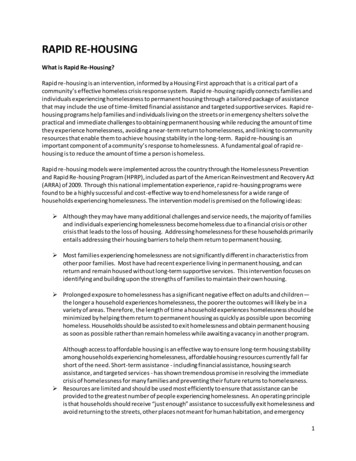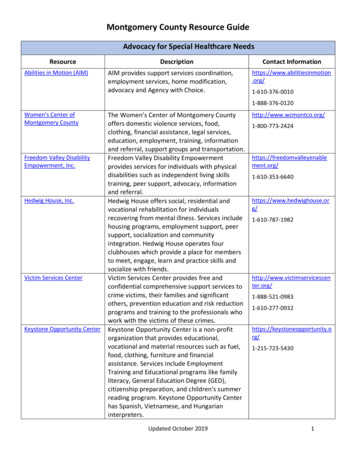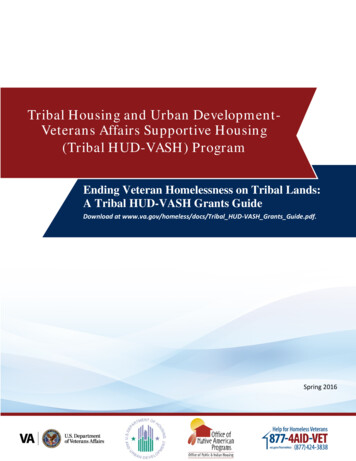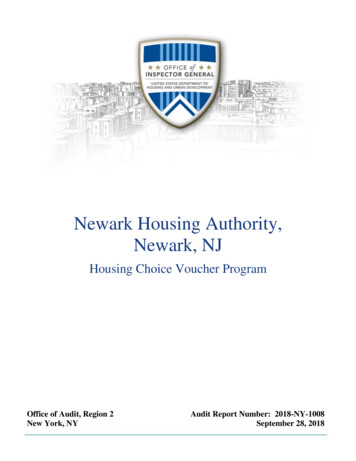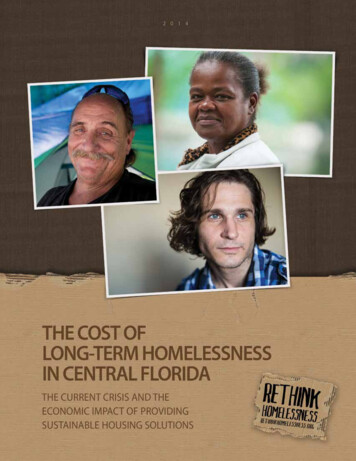
Transcription
This research study could not have beenpossible without the input and supportof many individuals and organizationswithin Central Florida. The funding forthis research and the release of this EconomicImpact Study was made possible by a generousdonation from the Orlando Solar Bears. TheCentral Florida Commission on Homelessnessthanks Orlando Solar Bears Hockey for being agreat community partner!“In November of 2011, the Orlando Solar Bears Hockey Club came ‘Out of Hibernation’ and returned toOrlando. Our primary goal was to ingrain ourselves within the fabric of the Central Florida community.With so much great work already being done by the good folks at Impact Homelessness we are proud toplay a small role in supporting the initiative of the Central Florida Commission on Homelessness.”– Jason Siegel, CEO, Orlando Solar BearsNames: Clifford Stuartand Sandra GeyerAges: 56 and 66Homeless: 7 yearsSandra and Clifford both worked in the hotel industry. When a new owner took over, they lost their jobs, lost their housing andended up living in the woods.ABOUT THE COVERThree photos were chosen to represent homelessness in Orange, Osceola, and Seminole counties. They were selected byphotographer Judy Watson Tracy who spent months photographing Central Florida's homeless for this report.Central Florida at Homeless CrossroadsMargarita Dopwell, age 55, homeless for two years. She works, but doesn't earn enough for a home of her own. She sleepsat night at the Coalition for the Homeless in downtown Orlando.IChris Brothers, age 31, homeless all his life. Lives on the streets and in motels in Seminole County.homeless and families who are homeless in Central Florida. The results of this study follow.From left to right:Robert "Tiny" Evans, age 57, homeless for 40 years, currently living in the woods in Osceola County.n 2013’s U.S. Department of Housing and Urban Development’s Annual Homeless Assessment Report,Central Florida was reported to have the most long-term homeless people in the nation for communitiesof like size. The Central Florida Commission on Homelessness decided to study the cost of homelessnesson the community and, too, take a closer look at funding options to create housing for both the long-termDesigned and illustrated by Jill ShargaaShargaa Illustration & Design www.shargaa.com Orlando, Florida1
Name: Brian Brackvitch(with Chunka the dog)Age: 48Homeless: 3 yearsBrian and his girlfriendlive in their van. He has adisability that keeps himfrom being able to work.CONTENTS456792ABOUT THE WRITER AND PHOTOGRAPHEREXECUTIVE SUMMARYDEFINITION OF TERMSTHE TYPES OF HOMELESSNESSLACK OF AFFORDABLE HOUSING ADDSTO HOMELESS CRISIS12 HOMELESSNESS AROUND AMERICA15 LONG-TERM HOMELESSNESS IS EXPENSIVETO THE COMMUNITY18 DON'T FORGET THE FAMILIES: MORE FAMILIES AREBECOMING HOMELESS IN CENTRAL FLORIDA20 THE COST OF DOING NOTHING IS NOT NOTHING222426272830OSCEOLA COUNTY INFOGRAPHICORANGE COUNTY INFOGRAPHICSEMINOLE COUNTY INFOGRAPHICHOSPITAL AND ER COSTSPROJECTED COSTS FOR THE TRI-COUNTY CoCCOST DIFFERENTIAL BETWEEN CHRONICHOMELESSNESS AND PERMANENTSUPPORTIVE HOUSING3335393940FINDING RESOURCES TO CREATE HOUSINGFOR THE HOMELESSREDUCING HOMELESSNESS ISAN ECONOMIC DRIVERHOUSING THE HOMELESS SAVED MONEY SAVED LIVESCONCLUSIONS AND RECOMMENDATIONSCONTRIBUTORS AND REFERENCES3
ABOUT THEWRITERABOUT THEPHOTOGRAPHEROver the past 20 years, a growingbody of research has documentedthe escalating cost of homelessnesson communities across thecountry. In general, it is now wellestablished that allowing homelessness to exist inGregory A. Shinn began hissocial work career in the 1980sworking in the homeless sheltersand doing street outreach in thesubways, parks, and flophouseson the Bowery in Manhattan. Hereceived his MSW from New YorkUniversity in 1993. From 1993 to 2001 he operated theJohn Heuss House, a shelter for homeless adults withmental illnesses in New York’s Financial District.In 2001, Mr. Shinn relocated to Oklahoma to workfor the Mental Health Association in Tulsa. As AssociateDirector he is responsible for the development andimplementation of many programs of affordable housingand additional services for people who are homelesswith serious mental illnesses and co-occurring disorders.The Association’s portfolio currently encompasses 26locations and 896 units across the city.For the past 10 years Mr. Shinn has worked withcommunities across the country on access to housingand economic development. In 2013, Mr. Shinn startedCreative Housing Solutions, a consulting firm providingassistance with community planning for systemsredesign and development of sustainable and affordablehousing solutions for ending homelessness. Specialareas of emphasis include community integration, jobdevelopment, neighborhood stabilization and returnon investment.4Judy Watson Tracy is along-time independentphotojournalist who has followedthe plight of the homeless formany years. She started hercareer in newspapers, workingin Atlanta and Orlando and itwas during her time with the Orlando Sentinel that shefirst began documenting the lives of the homeless.In addition to shooting pictures of the homeless inMetro Orlando, she traveled to communities acrossthe country, most prominently New Orleans. She hasbeen documenting how local governments tackle theproblems created by homelessness since the mid-1980s.More personally, she has served on the board of theHealthcare Center for the Homeless. She also has cookedfor and fed the homeless through the years, oftenalongside her two daughters, now adults.ExecutiveSummarya community is more expensive than providingthe solutions to the problem. Many communitiesacross the country have significantly decreasedhomelessness among the longest-term and disabledhomeless population – the chronically homeless by investing in solutions called Housing First1,2,3 andPermanent Supportive Housing4. These solutionsto homelessness combine access to housing that isaffordable5 for individuals with little or no incomeplus access to services. Studies comparing the costof public services used by chronically homelessindividuals to the costs of providing housing plusservices for the same population, show that“ allowing homelessnessto exist in a communityis more expensive thanproviding the solutionsto the problem.”developing affordable Permanent SupportiveHousing options reduces homelessness and savesmillions of taxpayer dollars over time, improvingthe quality of life for everyone. Further examplesdemonstrate that strategic planning to endhomelessness through the development of an arrayof housing options across a community creates jobs,generates tax revenue and leverages other fundingfor services and capital development back to thecommunity. Such planning can provide access tohousing for long-term homeless individuals andshorter-term or episodically homeless families aswell as other extremely low income households thatare priced out of the market.5
definition of termsAffordable HousingHousing costing no more than 30% of a household’sgross monthly income, according to the U.S. Departmentof Housing and Urban Development.Chronically HomelessSomeone is Chronically Homeless when they haveexperienced homelessness for a year or longer or haveexperienced at least four episodes of homelessness inthe last three years and have a disability.Continuum of Care (CoC)A program designed to promote community widecommitment to ending homelessness; provide fundingfor efforts by nonprofit providers, and State and localgovernments to quickly rehouse homeless individualsand families while minimizing the trauma and dislocationcaused to homeless individuals, families, and communitiesby homelessness; promote access to and effect utilizationof mainstream programs by homeless individuals andfamilies; and optimize self-sufficiency among individualsand families experiencing homelessness.Episodically HomelessSomeone is Episodically Homeless when they experiencerecurrent problems with housing, often due to seasonal/minimum-wage income jobs or sporadic domesticsituations that affect stable housing.HOME Investment Partnerships Program(the HOME Program)Program created to increase the supply of affordablehousing for low-and very low-income households byproviding jurisdictions with a dedicated funding streamto undertake four key affordable housing activities.Housing FirstAn approach to ending homelessness that centers onproviding permanent housing first and then providingservices such as mental health assistance as needed.6Pioneered by Dr. Sam Tsemberis from Pathways toHousing in New York City.HUD-VASHA voucher program through the Veterans Administrationthat provides permanent housing for eligible homelessVeterans who are single or eligible homeless Veteranswith families.Olmstead DecisionA United States Supreme Court case regardingdiscrimination against people with mental disabilities.The Supreme Court held that under the American withDisabilities Act, individuals with mental disabilities have theright to live in the community rather than in institutions.Permanent Supportive HousingA decent, safe, and affordable community-basedhousing that provides residents the rights of tenancyunder state and local landlord-tenant laws. The housingis linked to voluntary and flexible support and servicesdesigned to meet tenants’ needs and preferences.Rapid RehousingAn approach that focuses on moving individuals andfamilies that are homeless into appropriate housing asquickly as possible.Sadowski ActThis Act created the dedicated revenue source forFlorida’s affordable housing programs. Monies dedicatedfrom the Act to the state fund are called Sadowski funds.State Housing Initiatives Housing Partnership(SHIP) ProgramProgram created to serve very low, low, and moderateincome families. Funding is provided to localgovernments as an incentive to create partnerships thatproduce and preserve affordable homeownership andmultifamily housing.Permanent Supportive Housing - A decent, safe, and affordablecommunity-based housing that provides residents the rightsof tenancy under state and local landlord-tenant laws. Thehousing is linked to flexible support and services designed tomeet tenants’ needs.Affordable Housing - Costing no more than 30% of a household’sgross monthly income, according to the U.S. Department ofHousing and Urban Development. Often families need financialhelp such as rent and utility payment assistance, help overcomingbad credit, or help overcoming other barriers to obtain housing.Additionally, they often need other community services to remainin housing long term.Creative Housing Solutions was retained in late 2013by the Central Florida Commission on Homelessnessto study the economic impact of homelessness inCentral Florida and to identify solutions to the problemof homelessness which had reached a crisis point. Togather data for purposes of this report, the Commissionenlisted the cooperation of elected officials, thebusiness community, sheriff’s departments, correctionsdepartments, hospital administrators, mental healthproviders, homeless outreach teams, housing providersand others in Osceola, Orange and Seminole counties,as well as other nearby Florida communities. By addingactual and projected costs incurred in the publicdomain by long-term, chronically homeless individuals,including repeated incarcerations, emergency roomuse and inpatient hospitalizations and comparing themto the costs of permanent supportive housing withservices, we were able to demonstrate that providinghousing and services to the chronically homeless savesmoney and provides better outcomes.7
Our Findings Based on our study of a cohortof 107 chronically homelessindividuals, we calculated thatthe average annual cost to behomeless and cycling in and out ofAverage cost per yearfor the cohort forOrange, Seminoleincarceration, emergency rooms and inpatientand Osceola countieshospitalizations was 31,065 per person per year.is 3,323,955Average cost per year for the cohort for the tricounty area is 3,323,955, for a 10-year total cost of 33,239,553. Providing permanent supportivehousing for individuals with similar historiesof chronic homelessness and disablingconditions in Central Florida cost an average10-yeartotal cost of 33,239,553.for aof 10,051 per person per year, an annualcost savings of 21,014 per person, or acommunity cost reduction of 68%per person, per year.Cost savings of providing permanent supportive housing, just for the cohort of 107,calculating for a 10% recidivism rate, over a period of 10 years, would be a minimumof 20,236,482. Using this analysis, housing just 50% of the current chronichomeless population in Central Florida over a multiyear period, with a 10%recidivism rate, would save the taxpayers a minimum of 149,220,414.8Name: Arnold GarikowAge: 64Homeless: 15 yearsArnold knows several foreign languages and has a good education, but his inability to stop drinking keeps him on the streets.Lack of Affordable HousingAdds to Homeless CrisisCentral Florida has one of the highestrates of chronic homelessness amongveterans. The Orlando VA’s catchmentarea and Gap Analysis covers sixcounties (Orange, Osceola, Seminole,Lake, Volusia, and Brevard). Using the 2013 PointIn Time data, a projection of housing placementswere estimated for 2013 through 2015. Theanalysis estimated a need for 963 (564 for Orange,Osceola, and Seminole Counties) PermanentSupportive Housing Placements (2013-2015) forChronically Homeless Veterans. Within Osceola,Orange and Seminole counties, 429 veteransare currently housed in permanent supportivehousing through the HUD-VASH (Veterans AffairsSupportive Housing) with supportive servicesin place.8 The Orlando VA expects to receivehundreds of additional vouchers over the nextfive years and these veterans will need access tohousing units where they can use their HUD-VASHsubsidies and successfully reintegrate into thecommunity.However, the current crisis in both familyand individual homelessness in Central Floridais precipitated by the fact that there is a severeshortage of affordable housing in the area for low,very low and extremely low-income households.These income levels are established by the U.S.Department of Housing and Urban Developmentand are as follows: Low Income 51-80% of Area9
Median Income (AMI); Very-Low Income 31-50%of Area Median Income; and Extremely LowIncome (ELI) 0-30% of Area Median Income.According to the 2014 report from the UrbanInstitute (www.urban.org/housingaffordability),for the tri-county area comprising Central Florida,the currently available affordable housing stock inOsceola County is only four for every 100 ExtremelyLow Income households; Orange County has 13for every 100 Extremely Low Income households,and Seminole has 22 for every 100 Extremely LowIncome households. This leaves a three county totalgap of over 45,000 affordable housing units forextremely low-income households.9The National Low Income Housing Coalition’s“Out of Reach” state-by-state analysis reports thatfor 2013, 31% of all households in Florida are rentersand that 21%, or 432,892, of these households areExtremely Low Income.10 The State housing wage inFlorida, or the wage that is required to afford atwo-bedroom apartment is 19.14 an hour, whichis equal to 3,318/month or 39,811/year. 2014 FairMarket Rent as established by the U.S. Department ofHousing and Urban Development for the OrlandoKissimmee Metropolitan Statistical Area is 697/month for a studio, 825/month for a one-bedroomand 983/month for a two-bedroom apartment.11According to the U.S. Department of Housing andUrban Development, the housing affordabilitystandard is 30% of gross monthly income for rent.For a disabled person who qualifies forSupplemental Security Income (SSI) the monthlypayment in Florida is 720/month or 8,640/year. This means affordable housing for a disabledperson on Supplemental Security Income, at thestandard of 30% of their monthly income, wouldbe 216 per month. Put simply, Extremely LowIncome, homeless and disabled individuals, as wellas Extremely Low Income families, are completelypriced out of the market.This has created an affordable housing crisisfor households in poverty and is a majorcontributing factor to the escalating numbers ofhomeless in Central Florida. The longer someoneis on the street, the more they are at risk of10incarceration and major medical and psychiatricillnesses, and the less chance they have of beingable to get out of this vicious cycle.The findings in this economic impact reportare intended to be used as information to changethe current trajectory of increasing numbers ofchronically homeless individuals and families, andincreasing community costs. Sustainable, solutionfocused models for housing the homeless will savemoney while creating access, economic opportunity,community integration and neighborhoodstabilization. Community collaboration,coordination of available resources and alignmentof public policies toward the goal of endinghomelessness is imperative in order for progressto occur. Creative Housing Solutions previouslyprepared an outline for strategic public policyalignment in the State of Florida. Additional detailsregarding the strategic and coordinated planningefforts required to reduce homelessness can be foundunder the Conclusions and Recommendationssection of this report.Creative Housing Solutions is recommendingthe implementation of a strategic plan to developaccess to a minimum of 1,950 permanentsupportive housing units for chronically homelessindividuals, and another 3,050 affordable housingunits for families across the tricounty Continuum of Care, usingall available public and privateresources over a multiyear period of atleast five years. Using a mixed-income,mixed-population model for communityreintegration12 will create access toaffordable housing for households at30%, 50% and 60% of area medianincome. By dedicating 31% of theName: Phyllis Stroupaffordable units as permanentAge: 58supportive housing and prioritizingHomeless: 6 yearsthem to the most chronically homelessindividuals and families, chronicPhyllis is a Vietnam Veteran who has been homeless for six years prior tohomelessness can be functionallyreceiving a HUD-VASH subsidy for an apartment.eliminated from Central Florida.Using a low-density scatter-site approachCounty Summit, examining both familyacross all three counties ensures that nohomelessness and chronic homelessness where theone county, city or neighborhood is responsible forissues of unemployment, low-wage jobs and lack ofsharing an undue burden of ending homelessness;affordable housing are described in detail.13rather, it is the entire community’s responsibility.New requirements from the U.S. Department ofUsing this strategy, Creative Housing SolutionsHousing and Urban Development for 201414is recommending a resource developmentmandate that all Continuum of Care agenciesapproach that combines the use of existing andacross the country must implement anew resources to acquire and rehabilitate 1,800coordinated assessment and prioritizationunits of multifamily rental housing, across themethodology, such as the Service Prioritizationtri-county area, over a period of at least five years.Decision Assistance Tool (SPDAT).15 CreativeWhen combined with existing resources, thisHousing Solutions is further recommendingdevelopment plan will not only provide athat such assessment and prioritization systemsolution to chronic and family homelessness,changes be implemented simultaneously withbut also generate a direct economic impact ofcreating access to permanent supportive andat least 466,230,960 in jobs created and otheraffordable housing so that the neediest chronicallyindirect impacts on top of the future costshomeless individuals, homeless families and otheravoided by ending homelessness.Extremely Low Income households are accuratelyThough the cost of family homelessness is notassisted and offered the housing being developeddetailed here, the strategy for resource allocationthrough the strategic plan. By tracking the accessand integrated design for development ofcreated (housing placements) for the targetedaffordable housing includes solutions leading topopulation through the development of housingreduction of family and individual homelessness.across the Continuum, the multiyear savingsThe specific number of units dedicated to homeless(costs avoided) can be calculated into the overalland Extremely Low Income families can be foundReturn on Investment (ROI). As the new system isunder the Finding Resources to Create Housing for theimplemented and fine-tuned, the length of timeHomeless section of this report.from streets and shelters to housing placement willOsceola County previously funded threebe reduced, which can be tracked over time.reports for the State of Homelessness in Osceola11
HomelessnessAround AmericaIn 2013, The Central FloridaCommission onHomelessness initiatedregional planningwith local and stategovernments, boards, authorities,the Veterans Administration,nonprofit service providers,business leaders and others todecrease homelessness in CentralFlorida. The Commissionpartnered with triSect, LLC tostudy the models of 10 citiesacross the country that haveinitiated successful programs toaddress homelessness. A reportof this study, based on extensivesurveys and interviews wasreleased in October 2013.16Rethink Homelessness A Surveyof Best Practices: Communitiesmaking a Difference studied themetropolitan areas of Atlanta;Denver; Fairfax County, Virginia;Houston; Los Angeles; MarinCounty, California; Miami-DadeCounty; Minneapolis/HennepinCounty, Minnesota; NewOrleans; and Tulsa, Oklahomawhich have all demonstratedeffective planning strategies forreducing homelessness andcreating access to affordable12housing. These communities,among others, are recognized assuccessful models by the UnitedStates Interagency Council onHomelessness (USICH), theNational Alliance to EndHomelessness (NAEH), the U.S.Department of Housing andUrban Development (HUD), theSubstance Abuse and MentalHealth Services Administration(SAMHSA) and the VeteransAdministration (VA). As theCommission studied theoutcomes of the various cities’efforts, similar themes began toappear and evidence-basedpractices were identified as thekeys to these cities’accomplishments. The commonpractices being employed includeHousing First, PermanentSupportive Housing, HUD-VASH17and Rapid Rehousing18 for families.Leadership from every sector,collaboration and the use of gooddata for planning were essential toevery successful community plan.Finally, each of thesecommunities had studied thelocal cost of homelessness inpreparation for their strategicplanning resource allocationhousing and services to thehomeless is less expensive thanrepeated reliance on thecommunity resources. To quotethe 2009 Los Angeles EconomicRoundtable Report: “The findingthat homeless persons reducetheir utilization of acute careservices such as inpatienthospitalizations and jail stayssubsequent to housingplacement is nearly universal.”21Brief Review of Findings in Other Communitiesmodels. Approximately 50 coststudies have been conductedover the past 25 years. Landmarkstudies conducted in New YorkCity in 2002 by Culhane, et al19considered 4,679 homelessindividuals over the course of nineyears and the Economic RoundtableReport in Los Angeles in 200920studied 9,186 homeless “GeneralRelief” recipients and 1,007homeless disabled individuals withserious mental illnesses in and outof supportive housing. Many othercommunities and universities havealso released reports including theUniversity of Southern California;Vanderbilt; Tulsa, Oklahoma;San Francisco; Seattle; Louisville,Kentucky and San Diego, somestudying the cost of just dozens ofpeople while others consideringmore than 3,000 individuals orfamilies.The focus of these coststudies centered on the repeateduse of public services with thegreatest public expenditures,such as incarceration, emergencyroom use and inpatienthospitalizations for medicaland psychiatric illnesses. Eachstudy has found that providingThe studies all found a community cost savingsassociated with placement of chronicallyhomeless individuals in housing compared to thecost of the same population while living on thestreets and in the shelters. Nationally the annualcost savings ranged from 79% in Los Angeles22to 72% in Jacksonville, Florida,23 55% in Tulsa,2453% in Seattle,25 and 49% in Louisville.26This savings amounts to millions of dollarsper year in each instance, measured in localdollars and unique to each community.Sample of Cost Savings Per Person/Per Yearin Other Communities* Los Angeles: 23,836/year per person (n 376) equalscost savings 8,962,336/year for 376 individuals in study Jacksonville: 54,086/year per person (n 12) equals costsavings equals 649,032/year for 12 individuals in study Louisville: 26,280/year per person (n 34) equals costsavings 911,897/year for 34 individuals in study Seattle: 30,000/year per person (n 95) equals costsavings 2,850,000/year for 95 individuals in study*Cost savings reported in this study for CentralFlorida was determined to be 21,014 per personper year, a number only slightly lower than LosAngeles and Seattle even though fewer communitycosts were collected on the chronically homelesscohort. See the Being Homeless Is Expensive to theCommunity section of this report for more details.The State of Utah27 reports that they havereduced their chronic homeless population by 74%since 2005. Their coordinated outreach effortsand prioritized access to supportive housing withservices has reduced the number of chronicallyhomeless veterans to functional ZERO.28 Similarly,Phoenix, Arizona29 is now reporting functionallyZERO chronically homeless veterans. Thoughcost savings are not yet available on this newdata, these communities are demonstrating theeffectiveness of implementing a coordinatedcommunity strategy using the evidence-basedpractices of Housing First, Permanent SupportiveHousing, Rapid Re-housing and HUD-VASH toreduce and even end chronic homelessness.In addition, some cities like Tulsa, Oklahoma,whose Point in Time Counts for the past six yearsshow less than 100 chronically homelessindividuals30 have tracked the reduction in chronichomelessness for as many as 10 years and calculatedthe community cost savings per person byreducing chronic homelessness. By incorporatingthe economic impact of affordable housingdevelopment and adding the direct earnings injobs created, taxes paid and other funds leveragedback to the local community with homelessreduction cost savings, a more complete return onthe investment in the plan to end homelessnesscan be obtained.31 A more complete analysisprovides a fuller understanding of the cost ofallowing homelessness to exist in a communityversus the economic impact of providing long-termpermanent housing options with access to services.Being able to maintain the communitycost savings annually depends on the formerlychronic homeless person staying in the housingand not becoming homeless or incarceratedagain, nor experiencing long-term hospital stays.This rate of sustainability, known as HousingRetention, has been tracked using Housing Firstand Permanent Supportive Housing models asfar back as 2000.32 Maintaining basic fidelity toHousing First and PSH principles for provision ofhousing and services ensures a minimum annualhousing retention rate of over 80%, with manycommunities regularly reporting close to or evenover 90%.33, 3413
Concentration Areasof Long-TermHomelessnessin Central FloridaSmall red circlesrepresent clusters ofhomeless campsThis map represents concentrations of varying degrees of homelessness. It is not meant to be an exact measurement.The information was compiled by the Outreach Teams pictured on page 16.14Long-Term Homelessness isExpensive to the CommunityIn order to carry out thisstudy, three cohorts of someof the longest-term homelessindividuals in Osceola,Orange and Seminolecounties were identified andtracked by the number of knownepisodes of incarceration, instancesof emergency room use andadmissions for hospitalization,both medical and psychiatric.Identification of these individualsand their community costs wasmade possible by the assistanceof local Sheriff’s Departments,correctional facilities, hospitals,mental health providers andhomeless outreach teams.The study analyzesinformation on the communitycosts of 107 chronically homelessindividuals in Central Florida.This includes 37 from OsceolaCounty, 37 from Orange Countyand 33 from Seminole County.The individuals were identified bythe local homeless outreach teamsas those most frequently engagedby the teams, ensuring theywere truly chronically homeless.Public records for the frequencyof incarceration were providedby the Osceola County Jail, theOrlando Police Department, theOrange County Jail, the SanfordPolice Department, the SeminoleCounty Sheriff’s Department andJohn E. Polk Correctional Facilityin Sanford, Florida.These names were thensubmitted to Orlando Health,which reported data from OrlandoRegional Medical Center andSouth Seminole Hospital, and toFlorida Hospital, which reporteddata from seven hospitals in thearea: Altamonte Springs, Apopka,Celebration, East Orlando,Kissimmee, Orlando and WinterPark. The hospitals and medicalcenters cross-matched the list of107 chronic homeless namesprovided to them and in turnprovided de-identified informationon the individuals to theCommission for purposes of thisreport.It is important tounderstand that this reportprovides exact costs forincarceration of these identified107 confirmed chronicallyhomeless individuals in CentralFlorida and aggregated costs forhospitalization of these sameindividuals due to HIPAA laws.While this study does notquantify public service costs ofthese individuals while homelessand then after placement insupportive housing, it doesinclude analysis of costs forindividual
counties (Orange, Osceola, Seminole, Lake, Volusia, and Brevard). Using the 2013 Point In Time data, a projection of housing placements were estimated for 2013 through 2015. The analysis estimated a need for 963 (564 for Orange, Osceola, and Seminole Counties) Permanent Supportive Housing Placements (2013-2015) for Chronically Homeless Veterans.

